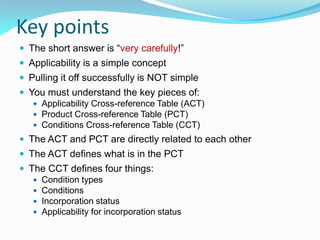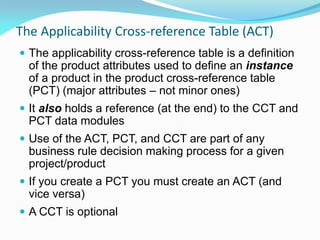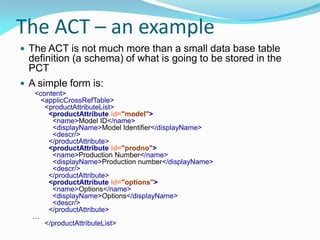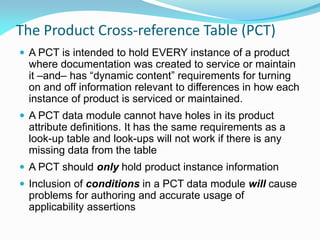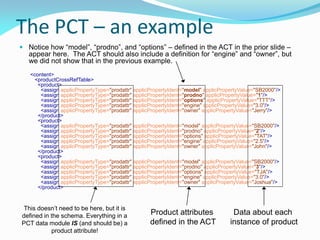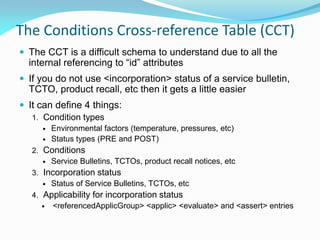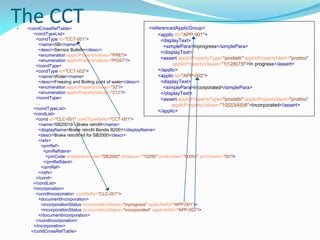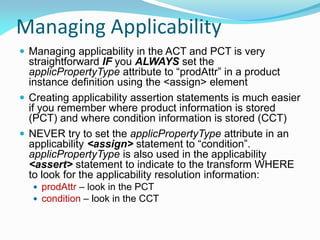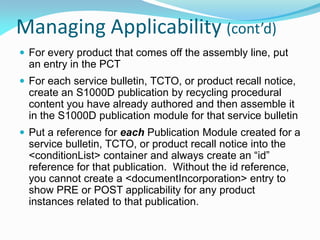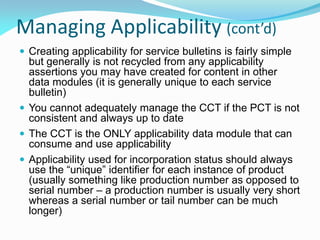How_Do_I_Manage_the_ACT_PCT_and_CCT
- 1. Mike Cook Senior S1000D Business Analyst S1000D e-Biz Forum 2015 Orlando, May 11 - 13
- 2. Key points ’éŚ The short answer is ŌĆ£very carefully!ŌĆØ ’éŚ Applicability is a simple concept ’éŚ Pulling it off successfully is NOT simple ’éŚ You must understand the key pieces of: ’éŚ Applicability Cross-reference Table (ACT) ’éŚ Product Cross-reference Table (PCT) ’éŚ Conditions Cross-reference Table (CCT) ’éŚ The ACT and PCT are directly related to each other ’éŚ The ACT defines what is in the PCT ’éŚ The CCT defines four things: ’éŚ Condition types ’éŚ Conditions ’éŚ Incorporation status ’éŚ Applicability for incorporation status
- 3. The Applicability Cross-reference Table (ACT) ’éŚ The applicability cross-reference table is a definition of the product attributes used to define an instance of a product in the product cross-reference table (PCT) (major attributes ŌĆō not minor ones) ’éŚ It also holds a reference (at the end) to the CCT and PCT data modules ’éŚ Use of the ACT, PCT, and CCT are part of any business rule decision making process for a given project/product ’éŚ If you create a PCT you must create an ACT (and vice versa) ’éŚ A CCT is optional
- 4. The ACT ŌĆō an example ’éŚ The ACT is not much more than a small data base table definition (a schema) of what is going to be stored in the PCT ’éŚ A simple form is: <content> <applicCrossRefTable> <productAttributeList> <productAttribute id="model"> <name>Model ID</name> <displayName>Model Identifier</displayName> <descr/> </productAttribute> <productAttribute id="prodno"> <name>Production Number</name> <displayName>Production number</displayName> <descr/> </productAttribute> <productAttribute id="options"> <name>Options</name> <displayName>Options</displayName> <descr/> </productAttribute> ŌĆ” </productAttributeList>
- 5. The Product Cross-reference Table (PCT) ’éŚ A PCT is intended to hold EVERY instance of a product where documentation was created to service or maintain it ŌĆōandŌĆō has ŌĆ£dynamic contentŌĆØ requirements for turning on and off information relevant to differences in how each instance of product is serviced or maintained. ’éŚ A PCT data module cannot have holes in its product attribute definitions. It has the same requirements as a look-up table and look-ups will not work if there is any missing data from the table ’éŚ A PCT should only hold product instance information ’éŚ Inclusion of conditions in a PCT data module will cause problems for authoring and accurate usage of applicability assertions
- 6. The PCT ŌĆō an example ’éŚ Notice how ŌĆ£modelŌĆØ, ŌĆ£prodnoŌĆØ, and ŌĆ£optionsŌĆØ ŌĆō defined in the ACT in the prior slide ŌĆō appear here. The ACT should also include a definition for ŌĆ£engineŌĆØ and ŌĆ£ownerŌĆØ, but we did not show that in the previous example. <content> <productCrossRefTable> <product> <assign applicPropertyType="prodattr" applicPropertyIdent="model" applicPropertyValue="SB2000"/> <assign applicPropertyType="prodattr" applicPropertyIdent="prodno" applicPropertyValue="1"/> <assign applicPropertyType="prodattr" applicPropertyIdent="options" applicPropertyValue="TTT"/> <assign applicPropertyType="prodattr" applicPropertyIdent="engine" applicPropertyValue="3.0"/> <assign applicPropertyType="prodattr" applicPropertyIdent="owner" applicPropertyValue="Jerry"/> </product> <product> <assign applicPropertyType="prodattr" applicPropertyIdent="model" applicPropertyValue="SB2000"/> <assign applicPropertyType="prodattr" applicPropertyIdent="prodno" applicPropertyValue="2"/> <assign applicPropertyType="prodattr" applicPropertyIdent="options" applicPropertyValue="TAT"/> <assign applicPropertyType="prodattr" applicPropertyIdent="engine" applicPropertyValue="2.5"/> <assign applicPropertyType="prodattr" applicPropertyIdent="owner" applicPropertyValue="John"/> </product> <product> <assign applicPropertyType="prodattr" applicPropertyIdent="model" applicPropertyValue="SB2000"/> <assign applicPropertyType="prodattr" applicPropertyIdent="prodno" applicPropertyValue="3"/> <assign applicPropertyType="prodattr" applicPropertyIdent="options" applicPropertyValue="TJA"/> <assign applicPropertyType="prodattr" applicPropertyIdent="engine" applicPropertyValue="3.0"/> <assign applicPropertyType="prodattr" applicPropertyIdent="owner" applicPropertyValue="Joshua"/> </product> Data about each instance of product Product attributes defined in the ACT This doesnŌĆÖt need to be here, but it is defined in the schema. Everything in a PCT data module IS (and should be) a product attribute!
- 7. The Conditions Cross-reference Table (CCT) ’éŚ The CCT is a difficult schema to understand due to all the internal referencing to ŌĆ£idŌĆØ attributes ’éŚ If you do not use <incorporation> status of a service bulletin, TCTO, product recall, etc then it gets a little easier ’éŚ It can define 4 things: 1. Condition types ’éŚ Environmental factors (temperature, pressures, etc) ’éŚ Status types (PRE and POST) 2. Conditions ’éŚ Service Bulletins, TCTOs, product recall notices, etc 3. Incorporation status ’éŚ Status of Service Bulletins, TCTOs, etc 4. Applicability for incorporation status ’éŚ <referencedApplicGroup> <applic> <evaluate> and <assert> entries
- 8. The CCT’éŚ <condCrossRefTable> <condTypeList> <condType id="CCT-001"> <name>SB</name> <descr>Service Bulletin</descr> <enumeration applicPropertyValues="PRE"/> <enumeration applicPropertyValues="POST"/> </condType> <condType id="CCT-002"> <name>Water</name> <descr>Freezing and Boiling point of water</descr> <enumeration applicPropertyValues="32"/> <enumeration applicPropertyValues="212"/> </condType> ŌĆ” </condTypeList> <condList> <cond id="CLC-001" condTypeRefId="CCT-001"> <name>SB20019 - Brake retrofit</name> <displayName>Brake retrofit Bendix B2001</displayName> <descr>Brake retrofit kit for SB2000</descr> <refs> <pmRef> <pmRefIdent> <pmCode modelIdentCode="SB2000" pmIssuer="10295" pmNumber="00001" pmVolume="00"/> </pmRefIdent> </pmRef> </refs> </cond> </condList> <incorporation> <condIncorporation condRefId="CLC-001"> <documentIncorporation> <incorporationStatus incorporationStatus="inprogress" applicRefId="APP-001"/> <incorporationStatus incorporationStatus="incorporated" applicRefId="APP-002"/> </documentIncorporation> </condIncorporation> </incorporation> </condCrossRefTable> <referencedApplicGroup> <applic id="APP-001"> <displayText> <simplePara>Inprogress</simplePara> </displayText> <assert applicPropertyType="prodattr" applicPropertyIdent="prodno" applicPropertyValues="1|12|6|7|9">In progress</assert> </applic> <applic id="APP-002"> <displayText> <simplePara>Incorporated</simplePara> </displayText> <assert applicPropertyType="prodattr" applicPropertyIdent="prodno" applicPropertyValues="10|2|3|4|5|8">Incorporated</assert> </applic>
- 9. Managing Applicability ’éŚ Managing applicability in the ACT and PCT is very straightforward IF you ALWAYS set the applicPropertyType attribute to ŌĆ£prodAttrŌĆØ in a product instance definition using the <assign> element ’éŚ Creating applicability assertion statements is much easier if you remember where product information is stored (PCT) and where condition information is stored (CCT) ’éŚ NEVER try to set the applicPropertyType attribute in an applicability <assign> statement to ŌĆ£conditionŌĆØ. applicPropertyType is also used in the applicability <assert> statement to indicate to the transform WHERE to look for the applicability resolution information: ’éŚ prodAttr ŌĆō look in the PCT ’éŚ condition ŌĆō look in the CCT
- 10. Managing Applicability (contŌĆÖd) ’éŚ For every product that comes off the assembly line, put an entry in the PCT ’éŚ For each service bulletin, TCTO, or product recall notice, create an S1000D publication by recycling procedural content you have already authored and then assemble it in the S1000D publication module for that service bulletin ’éŚ Put a reference for each Publication Module created for a service bulletin, TCTO, or product recall notice into the <conditionList> container and always create an ŌĆ£idŌĆØ reference for that publication. Without the id reference, you cannot create a <documentIncorporation> entry to show PRE or POST applicability for any product instances related to that publication.
- 11. Managing Applicability (contŌĆÖd) ’éŚ Creating applicability for service bulletins is fairly simple but generally is not recycled from any applicability assertions you may have created for content in other data modules (it is generally unique to each service bulletin) ’éŚ You cannot adequately manage the CCT if the PCT is not consistent and always up to date ’éŚ The CCT is the ONLY applicability data module that can consume and use applicability ’éŚ Applicability used for incorporation status should always use the ŌĆ£uniqueŌĆØ identifier for each instance of product (usually something like production number as opposed to serial number ŌĆō a production number is usually very short whereas a serial number or tail number can be much longer)
- 12. Thank you for your time.

